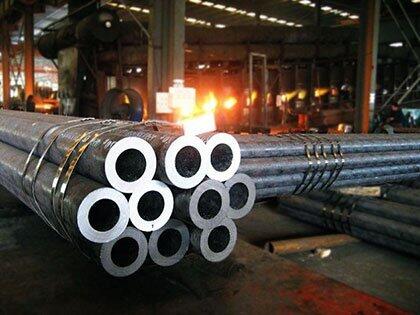Key Factors Affecting the Pressure Resistance of Carbon Steel Pipe:
The pressure resistance of carbon steel pipe (CS pipe) is not a fixed value but is determined by a combination of factors, including pipe material, wall thickness and outer diameter, manufacturing process, and operating temperature.
1. Material Grade
Ordinary carbon steel (such as Q235) has a tensile strength of approximately 375-500 MPa, while high-strength carbon steel (such as X60) can reach over 517 MPa (referring to API 5L standard). The higher the material strength, the greater the pressure resistance.
2. Wall Thickness and Outer Diameter
According to the Barlow formula (P = (2 * S * t) / D, where P is the pressure resistance value, S is the material tensile strength, t is the wall thickness, and D is the outer diameter), for the same material, a 1mm increase in wall thickness can increase pressure resistance by approximately 10-15%. For example, a DN100 SCH 40 carbon steel pipe (6mm wall thickness) has a working pressure of approximately 5.6 MPa, while SCH 80 (8mm wall thickness) can reach 7.4 MPa (ASTM A106 data).

3. Manufacturing Process
Seamless steel pipe (such as ASTM A106) can withstand higher pressures than welded pipe (such as ASTM A53) because it lacks weak points like weld seams.
4. Operating Temperature
As the temperature rises, the material strength decreases, and the allowable pressure decreases. At room temperature, the allowable stress of ASTM A106 Grade B steel is approximately 138 MPa. When the temperature rises to 400°C, the allowable stress drops to around 100 MPa.
Pressure Rating Indication Method:
In engineering, pressure ratings are primarily expressed in two ways:
1. Nominal Pressure (PN)
This is a standardized pressure rating notation commonly used for piping components such as valves and flanges. It represents a reference value related to the mechanical properties of the piping component. The PN value itself is not a measurement, but a label.
Common grades include: PN6, PN10, PN16, PN25, PN40, PN63, PN100, etc.
For example, a flange labeled PN16 has a maximum allowable working pressure of 16 bar (approximately 1.6 MPa) at 20°C. As the temperature rises, the maximum allowable working pressure decreases.
2. Wall Thickness Series (Schedule, Sch)
This is the most commonly used method for expressing the pressure capacity of seamless and welded steel pipes. The Schedule Number is a dimensionless number representing the wall thickness grade of the pipe. Its calculation formula takes into account the design pressure and the material's allowable stress.
As a general rule, the larger the number after the Sch, the thicker the wall and the higher the pressure capacity.
Sch5S/Sch10S: Thin-wall series (S stands for stainless steel, but carbon steel is also acceptable).
Sch20/Sch30: Less common.
Sch40/STD (Standard): Standard weight, most commonly used.
Sch80/XS (Extra-Strong): Extra-heavy weight, used for higher pressures.
Sch120/Sch160/XXS (Double Extra-Strong): Extra-heavy weight, used for high-pressure pipe.
Note: For pipes with the same schedule (e.g., Sch40), the actual wall thickness varies for pipes with different nominal diameters (DN), but they still belong to the same strength series.
Standard Specifications and Pressure Rating References:
Different international standards clearly classify the pressure resistance of carbon steel pipe:
1.
ASTM A106 Seamless Pipe: Grade B has a maximum working pressure of 15.8 MPa at room temperature (for a wall thickness of 12 mm and a DN of 150).
2.
API 5L Line pipe: X42 grade steel pipe for oil and gas transportation is typically designed for a pressure of 10-12 MPa (with a safety factor of 0.72).
3. National Standard GB/T 8163: The allowable pressure for #20 carbon steel pipe at 20°C is 6.4 MPa (5mm wall thickness, DN80).
Application Standards and Safety Factors:
Different industries have different pipeline safety codes, each with its own safety factor.
ASME B31.1 (Power Piping): Commonly used in power plants and boilers.
ASME B31.3 (Process Piping): Commonly used in petroleum, chemical, and refinery industries.
Even with identical materials, dimensions, and temperatures, the allowable pressures calculated according to different codes may differ slightly.
Selection Recommendations for Practical Applications:
1. Safety Factor: Industrial piping typically uses a safety factor of 1.5-4 times the design pressure (a higher value is used for flammable media). For example, steam piping requires an additional corrosion allowance according to ASME B31.1.
2. Temperature Correction: The pressure resistance of carbon steel pipe decreases by approximately 20-30% at high temperatures (>200°C). The material temperature reduction factor should be considered.
3. Corrosive Environment: If the medium contains H₂S or CO₂, sulfur-resistant carbon steel should be used or the design pressure should be reduced by at least 30%.
How to Select the Correct Pressure Rating for a Project?
1. Determine Design Conditions: Identify the system's design pressure and design temperature.
2. Select Material: Select the carbon steel grade based on the fluid's corrosiveness, temperature, and pressure.
3. Determine Pipe Diameter: Based on the required flow rate and velocity, calculate the required pipe ID and determine the standard OD.
4. Calculate or use a table to select wall thickness:
Calculation: Use the above formula, substituting the design pressure, OD, and material allowable stress, to reverse-calculate the required minimum wall thickness t.
Table Lookup: Based on the calculated minimum wall thickness, compare it to the ASME B36.10 standard wall thickness table and select a schedule number (such as Sch40 or Sch80) with an actual wall thickness no less than the calculated value.
5. Verification: Ensure that the pressure-temperature rating of the selected pipe (calculated) exceeds the system requirements under all operating conditions, with an appropriate safety margin.
Read more: Schedule 80 Carbon Steel Pipe


